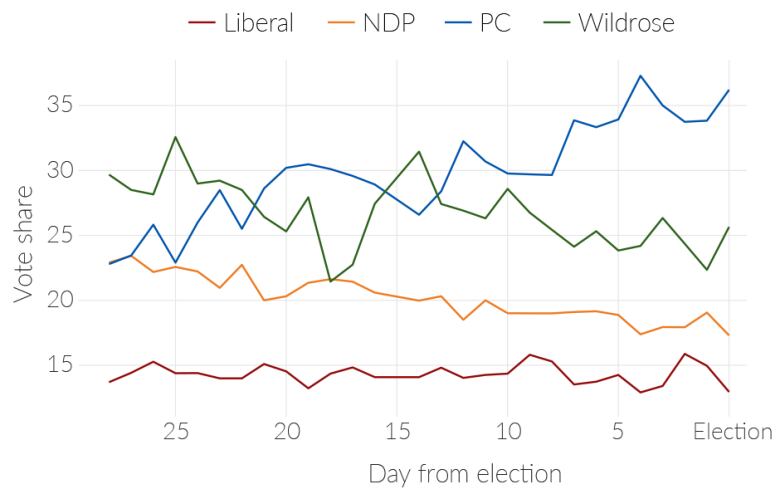Albertans predict PC majority despite polls giving edge to NDP
Polls can accurately capture intentions, but behaviour at the ballot box can be different
If the polls are to be believed, next Tuesday Albertans will vote to end the Progressive Conservative dynasty in the province after a record 44 years in power.
But Albertans remain skeptical about the prospects of a change in government come May 5, and for good reason.
Pollsters in Canada have weathered serious blows to the credibility of their election forecasts in recent years perhaps none so memorable as in the last Alberta election, where predictions of a Wildrose win were scuttled by a PC sweep of the province.
Couple this with the fact that half the voting-age population in Alberta has never known a ruling party other than the PCs, and there is cause for doubt about a reversal of electoral fortunes.
Drawing on data from the Alberta edition of Vote Compass, which has been used by more than 165,000 Albertans since the start of the campaign, we observe a similar trend in declared vote intention to that reported in the polls. If the findings hold, the NDP is poised to form a majority government.

One reason to suspend disbelief about the likelihood of this outcome is the demonstrated accuracy of Vote Compass data when it comes to forecasting trends in vote intention. The surprise landslide victory of the PCs in 2012 was no surprise at all when viewed through the lens of Vote Compass, which detected the resurgence of the PCs and the decline of the opposition parties Wildrose in particular relatively early in the campaign.

A big disconnect
Albertans, however, maintain a healthy dose of skepticism about whether pollsters' predictions will hold true come Tuesday. When asked which party they expect to win in their riding, Albertans project a dramatically different result than when they are asked who they intend vote for.
Albertans in 56 ridings across the province anticipate that their local PC candidate will be victorious on election day more than enough to secure another PC majority although the public consensus about these projections varies substantially by riding.
The following map visualizes the expected winner of each riding as predicted by that riding's residents. The colour of the riding represents the party that residents expect to carry the vote, and the shade indicates the strength (or weakness) of the local consensus as to the prospective victor.
The disconnect between who voters say they will vote for and who they think will win is an important aspect of election campaigns. It highlights the difference between attitudes and behaviour, whichcouldbe particularly consequential to the outcome of the Alberta election.
Polls can encourage strategic voting
Polls arethemselves culpable in shifting electoral fortunes. Their ultimate effect on the final vote tally in Alberta is yet to be revealed, but polling data presumablycontributed to the magnitude of the PC victory in 2012, as concerns over a potential Wildrose government prompted more PC voters to follow through at the ballot box and even prompted campaigns by progressive voters in Alberta to vote strategically for the PCs.
Whether the prospect of an NDP majority government in Alberta will catalyze the inverse effect among conservative voters is yet to be seen, although it seems less likely given lingering animosity among Wildrose supporters regarding the defection en masse of their MLAs to the PC government last December.
The gradual momentum of the NDP in the currentpolls may have actually prompted on-the-fence voters to support a prospectiveorange crush in Alberta.
Vote Compass data from the 2011 Canadian federal election shows thatpolls had a similar bandwagoning effect that favoured theNDP. A criticalsurge in support for Jack Layton and his party occurred on a day when three separate polls were released, each indicating a rising support for the NDP. The polls essentiallyhad the effect of exacerbating NDP vote share, as they may have had in Alberta.
The difference in 2011, however, was that local residents put greater stock in the prospects of the federal NDP in their respective ridings. This ostensibly pulled out the NDP vote on election day. In Alberta, a poor polling track record blunts optimism about change and engenders resignation to the status quo, which may well see NDP supporters refrain from trekking out to the ballot box.
Election day in Alberta will determine whether the polls or the Albertan people themselves were better able to predict the election results. One thing is for certain: the days of referring to Alberta elections as boring and predictable are past.
But there is a more important lesson that can be drawn from this election.
All the energy spent speculating about the accuracy of polls and the outcome of the campaign loses its value the moment the ballots are counted. The enduring value of public opinion research lies not in predicting the behaviour of voters on election day, but in better understanding the views of all citizens towards the issues that affect them every day.
A focus on horse race politics diminishes the practice of public opinion research, which has the potential to enhance the depth and breadth of electoral politics by exploring public attitudes towards issues rather than gauging ephemeral vote intentions.
Establishing robust, reliable assessments of public opinion on a wide array of public policy issues can prompt more responsive governments, irrespective of who carries the day once the votes are cast.













_(720p).jpg)


 OFFICIAL HD MUSIC VIDEO.jpg)
.jpg)



























































































